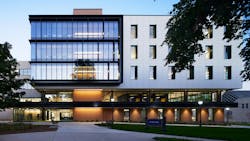It’s a harsh reality that buildings can be deadly to birds. From sparrows to hawks, our feathered friends can crash into a glass facade that reflects the sky or vegetation. The good news is that a bird-friendly design is one of the simpler sustainability goals to achieve. Don’t let these misconceptions deter you from creating a building that encourages safe navigation for birds.
1. Glass Facades Are the Only Problem
Large expanses of glass are an undeniable issue because birds don’t recognize an image as a reflection. Unlike humans, they can’t detect situational cues like frames, smudges, or mullions to alert them to the presence of a vertical surface. There’s also the fact that what looks opaque to a person looking at an angle may be the opposite to a bird flying at eye level. It’s why glass skyscrapers aren’t the only source of perilous architecture.
“There’s a persistent misunderstanding that tall glass buildings are the main problem. But the vast majority of commercial buildings are less than 10 stories,” says Dr. Christine Sheppard, senior director of the Glass Collisions Program for the American Bird Conservancy (ABC). “There’s also a strong correlation between bird strikes and glass that reflects trees or other landscaping, which happens closer to ground level.”
Glass railings, entrances, storefronts, mitered corners, atriums, canopies, stairwells, and skywalks can give the illusion of open space. Even green roofs and landscaped terraces can be a downfall—consider how many are intentionally positioned near windows for an attractive view.
“Excessive lighting is another challenge,” adds Sheppard. “It’s not only an energy conservation issue but negatively impacts humans and wildlife. Birds are especially vulnerable during migration when their flight paths can be disrupted. Participating in a Lights Out program is a good measure regardless of the season and will benefit your utility bill.”
2. Bird-Friendly Design Isn’t Attractive
Throw away the notion that bird-friendly architecture will detract from aesthetics. ABC’s best practice is to add a 2- by 2-inch pattern of dots or stripes to glass, which is an update over previous guidance in order to accommodate smaller species like hummingbirds. The grid is enough for a bird to recognize the space isn’t passable at a safe distance so it can change course.
“There’s an unfounded worry that people will see big, ugly dots on the glass, but the pattern is actually minimal. Our perception allows us to see through it, so these treatments don’t impede views to nature or hinder a clean line of sight,” explains Dan Kalkman, a senior project architect for HGA. “There are even some UV coatings that are nearly invisible.”
“Bird-friendly design isn’t a warehouse with no windows,” Sheppard emphasizes. “There are many solutions that are pleasing to the eye, such as undulating ceramic frit, acid etched, glazing, patterned laminates, glass blocks, facade screens, mirror glass, and decals. It’s far from a design constraint.”
3. It’s Not a Code Requirement
Perhaps not yet, but there’s growing momentum to formalize requirements. Notable examples: San Fransisco released standards for bird-safe buildings in 2011, New York City adopted theirs in 2019, and Madison, Wisconsin, approved an ordinance in 2020. Washington, D.C. is one of the latest participants, with a 2024 act that requires bird-friendly materials up to 100 feet above grade.
“These are similar to any other easement or setback code that specifies where to protect a building,” Kalkman points out. “Bird-friendly design often starts as a 50-foot zone from the ground level and a 20-feet buffer for green roofs.”
4. There’s An Extra Cost
Bird-friendly solutions won’t bust your budget. Especially for new construction, they are simply another factor when selecting the design intention for the facade.
“Make sure to compare lifecycle costs between glass and film products,” recommends Kalkman. “Adhesive solutions often have a shorter lifespan and ongoing maintenance, though they can be ideal as a retrofit when window replacement isn’t an option. Conversely, while there can be a slight premium for etch or frit glass over standard, it can also be offset with gains to thermal performance.”
A window replacement or facade renovation project is an opportune moment to incorporate bird-friendly features. For example, Marquette University in Milwaukee transformed its Straz Hall from a business school to the nursing college (pictured). HGA designated a bird-collision zone 60 feet above grade and selected a glass with a UV pattern.
5. There Are No Other Benefits
It’s a fallacy that anti-collision options only have a single function. Not only can they contribute to a building’s architectural statement, but they can also support daylighting strategies. Many bird-friendly glass treatments can be used to deliberately reduce solar heat gain and glare, positively impacting heating and cooling loads.
Protecting birds is a win for any company’s ESG efforts. These measures acknowledge that the built environment can and should contribute to the ecosystem.
“Every building has a responsibility to respect the environment not only for energy and water but also animals. The reality is that bird populations have declined by nearly 3 billion birds since 1970,” stresses Kalkman. “Additionally, architects and building owners should view bird-friendly design from a holistic perspective. These solutions complement other sustainability efforts for energy, daylighting, integrated pest management, and landscaping.”
About the Author
Jennie Morton
A former BUILDINGS editor, Jennie Morton is a freelance writer specializing in commercial architecture, IoT and proptech.

